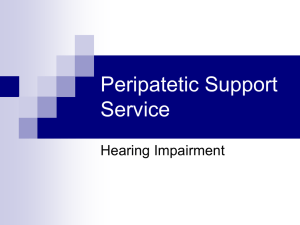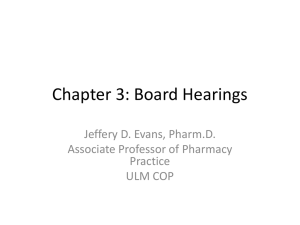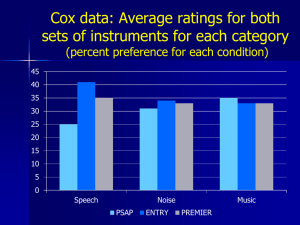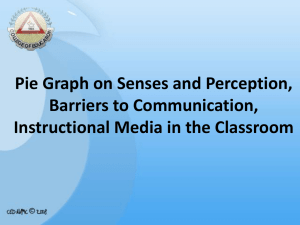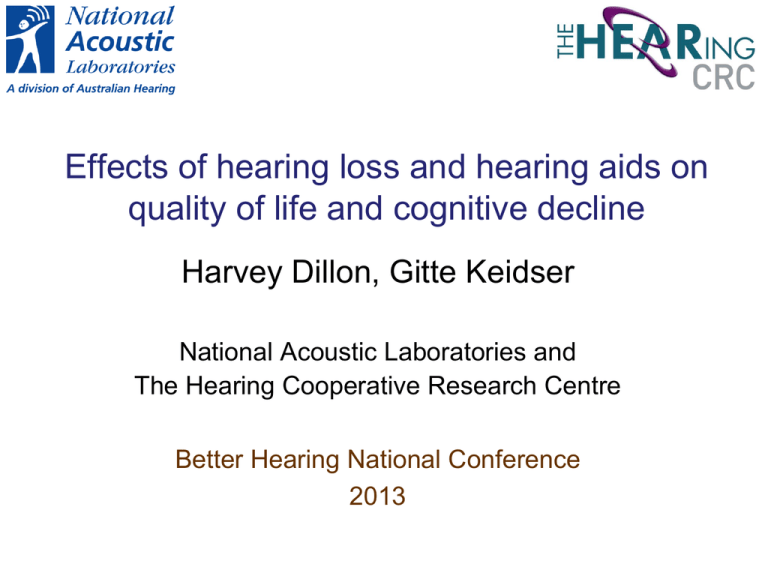
Effects of hearing loss and hearing aids on
quality of life and cognitive decline
Harvey Dillon, Gitte Keidser
National Acoustic Laboratories and
The Hearing Cooperative Research Centre
Better Hearing National Conference
2013
Impact of untreated hearing loss on health
• Proven links between hearing loss and:
– depression / mood / emotional state
– social isolation, loneliness, withdrawal
– self-sufficiency
– cognitive ability
– physical and psychological well-being
– life expectancy
• Asserted links between hearing loss and:
• anxiety
• anger / irritation
• paranoia
• distress / fear
• exhaustion
• embarrassment
• insecurity
• unemployment
• loss of group affiliation
• restricted travel
• loss of intimacy
Effects of hearing loss?
Hearing loss
Mortality
Cardio-vascular
disease
Depression
Activity
restriction
We just can’t deduce causation from these surveys of health
Effects of hearing aids?
Mortality
Depression
Hearing loss
Isolation
Anxiety
Insecurity
etc
Cross-sectional studies
Hearing loss
Better:
Less isolation.
More able to deal
with problems
Mood / less depression
Emotional state
Self-sufficiency
Social relationships
Hearing loss and hearing aids
Life expectancy
Cross-sectional studies
Fatalistic people
(external locus of control)
Hearing loss
Better:
Pro-active people
(internal locus of control)
Mood / less depression
Emotional state
Self-sufficiency
Social relationships
Hearing loss and hearing aids
Life expectancy
Cross-sectional studies
Unwell people,
with hearing loss
Attend to
major sickness
Hearing loss
Attend to
hearing loss
Better:
Healthy people,
with hearing loss
Mood / less depression
Emotional state
Self-sufficiency
Social relationships
Hearing loss and hearing aids
Life expectancy
Hearing loss, hearing aids and
cognitive decline
Longitudinal studies
Better:
+
Social relationships
Cognitive functioning
Memory
Hearing loss
Learning ability
Less depression
Less paranoia
Mulrow et al (1990); Dye & Peak (1983)
Longitudinal study:
Lin et al (2013) Johns Hopkins Centre, USA
Sample
• 1,984 adults, mean age =77 years, no dementia
• 58% had hearing loss (>25 dB 4FA in better ear)
• Cognitive ability measured 6 years later
Results
• Those with hearing loss had rate of cognitive decline 37%
greater than those with no loss
• Rate of decline increased significantly with hearing loss
• Rate of decline much less for those with hearing aids, but
difference not statistically significant & not randomised
– Adjusted for age, sex, race, education, smoking status, hypertension, diabetes
mellitus, stroke history
– Cause and effect likely but not proven
Rate of cognitive decline per year
Effect of hearing loss on
cognitive decline
Rate of cognitive decline per year
*
*
Beneficial effect of hearing aids
Effects of hearing loss
Isolation
Hearing
loss
Poor speech
understanding
Poor
Working
memory
Something else
Cognitive decline,
dementia
UK Biobank
• Extensive data on over 100,000 people
• Aged 40 to 69 years
• Relation of hearing loss to other factors
being analysed by Dr Keidser at NAL
• Attempting to investigate path from
hearing loss to depression and cognitive
abilities by statistical methods
UK Biobank data
No hearing loss
Hearing loss
Hearing loss in the future
Proportion of population with >=25 dB 4FAHL
Percentage of
population
25.0%
20.0%
70 & over
15.0%
60-69
10.0%
50-59
5.0%
15-49
0.0%
2003
2006
2011
Year
2021
2031
Why do people hear but
not understand?
….. and what NAL is doing about it
Noise damaged
Good
What can go wrong?
The hair cells can die (noise, drugs, age)
Vowel spectra and audibility
Sound level
oo
ee
250
First formant
500
Second formant
1000
2000
Frequency (Hz)
4000
Reduced dynamic range with hearing loss
Too
loud
Intense
Moderate
Weak
Too
soft
(a)
Norm
Too
loud
Intense
Moderate
Weak
Intense
Moderate
Weak
(b)
Too
loud
Too
soft
(c)
Sam
Too
soft
Prescribing hearing aids to maximise
intelligibility and control loudness
NAL-NL2 (2011)
NAL-NL1 (1999)
NAL-RP (1991)
NAL-R (1986)
NAL (1976)
Deficit (VCV & CUNY), HL, Q10, OAE, TEN, Cog, & Age: 5600 Hz low pass
es-SIIeff (VCV Avg(QH QL N) LP5600)
SIIdes-SIIeff (CUNY Avg(QH QL N) LP5600)
L56HL
Q10 LP56
COAE L56
EL LP56
Cognition
AgeLim
But hearing is still not normal!
Sound level
Frequency resolution in hearing loss
(a)
Excitation
250
1000
4000
1000
4000
(b)
250
Frequency (Hz)
Super-directional microphones
NAL binaural beamformer
+
+
Right
Front
Beamformer
and DOA
Delay
Right
HRTF
DOA
Left
+
+
Mejia
Left
To CAPD
To end
Outcomes of children with hearing
impairment
Teresa YC Ching, and team
We measure outcomes as children grow, …
Outcomes
• Expressive
Communication
• Auditory
comprehension
• Receptive vocab.
• Expressive vocab.
•
•
•
•
Language
Speech
creating sound valueTM
Articulation
Phonological dev
Speech perception
Spatial release
from masking
•
•
•
•
Reading
Writing
Math reasoning
Numerical
operations
Literacy &
numeracy
• Aural-oral
function in
real life
• Pragmatics
• Strengths and
difficulties
• Educational
attainment
• Employment
Psychosocial skills
Education &
employment
T Ching, NAL, HEARing CRC
At 5 years, early CI linked to better outcomes
(n = 104)
creating sound valueTM
T Ching, NAL, HEARing CRC
So baby, how does it sound?
Objective hearing aid
evaluation for:
• young infants
• difficult-to-test people
35
HearLab
Hearing disorders in the brain
Parietal lobe
Frontal lobe
Occipital lobe
Temporal lobe
Sylvian fissure
Superior temporal
gyrus
Spatial Processing Disorder
Lack of spatial release from masking
Noise
Noise
Speech
Noise
Noise
Cameron, Dillon & Newall
LISN & Learn Game
Target at 0˚:
Distracters at
+ and -90˚:
Target: The horse kicked six wet shoes
LiSN & Learn SRT (dB)
Better
LiSN & Learn - Performance Over Time (n=9)
10 dB
Cameron & Dillon (2011)
Randomized Control Trial
Cameron, Glyde & Dillon (2012)
Lisn & Learn
N=5
Earobics
N=5
3
Pre-training
Post-training
2
1
0
-1
-2
(Population Standa
LiSN-S Score
-3
-4
-5
-6
Low Cue
Talker Adv
Total Adv
High Cue
Spatial Adv
Low Cue
Talker Adv
Total Adv
High Cue
Spatial Adv
Group: LiSN & Learn
Group: Earobics
Future research
Central processing disorders in elderly people
Blue Mountains Study: Golding et al (2004)
• Studied 1576 people > 55 years
• Battery of 7 tests
• 76% failed 1 or more tests
• 64% failed 2 or more tests
But can we give training to overcome it?
Thanks for listening
www.NAL.gov.au
Volunteers needed !
NAL is funded by the Federal Department of Health,
Office of Hearing Services.



